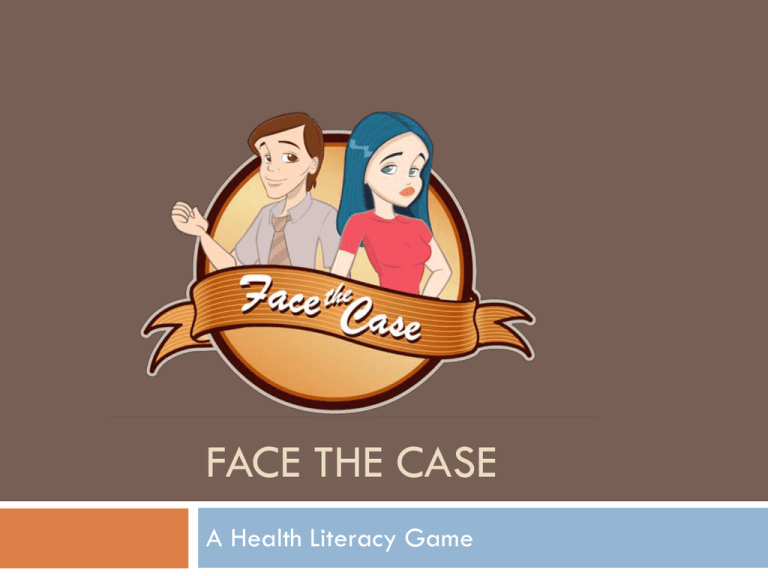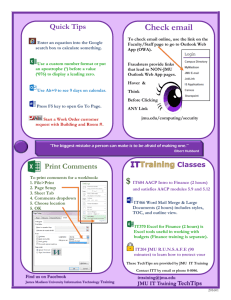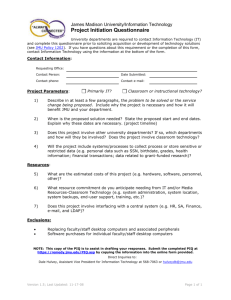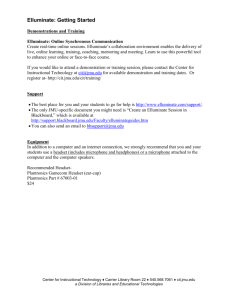FACE THE CASE A Health Literacy Game
advertisement

FACE THE CASE A Health Literacy Game Overview Face the Case is a quest to acquire the skills in order to solve a variety of health and human services cases in a role-playing environment that is engaging, challenging and visually interesting Case descriptions are delivered through the PDA, which also keeps track of the skills, skill points and collaborators for each player Intended audience is undergraduate nursing, health science, and social work students Overview – Screenshots The game takes place in a world based on the JMU community. Players receive cases on the PDA. Overview – Screenshots Players answer questions to get points. Once they have enough points they can buy skills. Overview – Game Play Sequence Info Emporium Buy Bling Culture Bazaar Login Review Case Study Communications Market Collaboration Cafe Face the Case Play the Game http://ftc.cit.jmu.edu Background What is a game? Levels Open-ended quest New skills/powers Rewards Ability to fail and try again High scores What is fun? Sensual Surprising Challenging Audience 1,200 undergraduate allied health students (e.g. future nurses and social workers) Game is aimed at a population of preprofessionals whose course of study is preparing them for careers in which they will interact with a diverse population of patients/clients who have complex and diverse health and human services needs Pedagogy What is health literacy? What kinds of skills are needed to achieve health literacy? Health Literacy: The degree to which individuals have the capacity to obtain, process, and understand basic health information and services needed to make appropriate health decisions. Information seeking Communication Cultural competence How can these skills be developed in a game? Technologies Graphical game interface and avatar creation app are Adobe Flash objects (SWFs) running in a web browser User profiles and history, skill sets and inventories, cases and case histories, etc. are stored in a SQL Server 2005 Express database Flash client and database communicate via ASP .NET Web Services (SOAP) An ASP .NET web application is used to self-create player profiles, to host Flash content, and to manage database content Technologies Browser with Flash plug-in SQL Server Express Internet .NET C#, SQL Windows 2003 server with IIS 6.0 Browser with Flash plug-in Browser with Flash plug-in Technologies – Database Technologies – Screenshot Project Team Jennifer McCabe (JMU): Game designer, project manager, subject matter specialist, content creator Kevin Hegg (JMU): Game designer, programmer, database developer Venture Interactive, LLC: Flash programming, animation, graphic illustration CIT: Graphic design support, instructional technologists JMU nursing students: Game testers Resources & Timeline Budget: $75,000 to $100,000 Timeline: One to two years People: many… Lessons Learned Browser issues (technology issues) Student comments (positive & negative) Usability testing Testing with students Next Steps? Extend functionality (messaging, more bling, more cases, more mini-challenges, player interaction and collaboration, etc.) Make content extendable (e.g. for teaching Information Literacy) Integrate into curriculum Release to general public under open source license Tighten security Tic Tac Toe game (games within the game) Funding This project was generously funded by a National Leadership Grant (#LG06-05-0150-05) for Research & Demonstration from the Institute of Museum and Library Services. Questions? JMU faculty, staff and students may go to http://ftc.cit.jmu.edu to create a user account and begin playing immediately Non-JMU people may create a user account but must wait for account to be validated by game administrators




